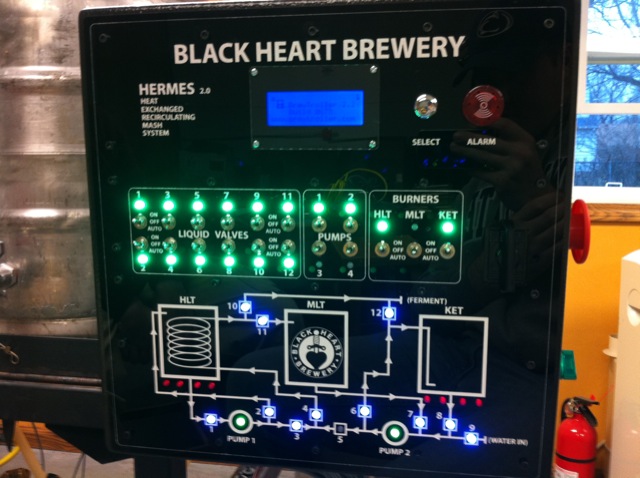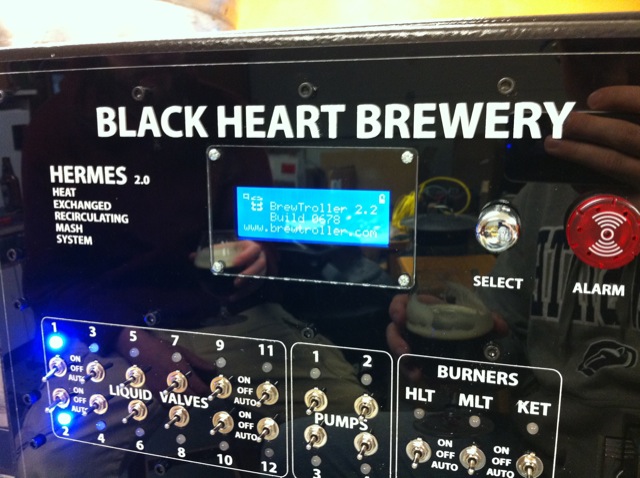blackheart
Well-Known Member
After some more wiring, testing, soldering etc, we are nearly 100% done with the build and ready to start testing!
Their is good news/bad news so lets start off with the good news....
We wired all the status lights on the control panel, Here is everything lighting up and working correctly! pretty cool looking.

And here we are testing BrewTroller, which appears to be working great so far.

The good news is that nearly ALL of the valves, switches, and status lights work correctly, that being said, some are still being a little bit fidgety.
First issue is valve 5 works... but after it opens it sounds like its trying to close and open again or like it doesnt know its open... like a broken automatic door that closes, opens slightly, then closes again... this only happens when we open the valve, and we tested the contacts for shorts, used a different wire and switch etc, its definitely the valve... Also, the valve 5 status LED isnt working, but we havent fully investigated that yet as the valve is acting funny regardless.
Second issue, when programing the valve configurations, the brew troller is unable to auto control valve 8. We can manually turn on valve 8, but testing reveals that the signal from the BT never reaches the relay board, let alone the switch. Not sure how to further trouble shoot this.
Third issue, the temperature probes are not working at all. We have multiple probes from brewers hardware, we have had them working with an arduino and a 1-wire code before. All connections have been tripple checked. When plugging the sensors, or just one sensor, into the BT4.0 1-wire board the LED on the USB board turns off and when rebooting with the 1-wire board in and connected to the sensors it only displays the LCD I2C address and never makes it into the BT menu. Also, after sensor is plugged in the controller becomes non responsive. When removed, it starts working again. We tripple checked for shorts etc, tried different combos of sensors yet got the same results each time.
Those are all of the Brew Troller related issues...
One other issue we had was with one of our pumps in the manifold. One pumps great, the other not so much. Funny part is, the pump thats not working great is our water pump that has only been used on the HLT. So, fairly certain that its not clogged but we havent checked. It is making a higher pitched noise than the other pump which is making a lower pitched rumble when pumping. Both pump, however one is a trickle.
If anyone can help us trouble shoot any of these issues it would be a big help. Thanks!
Their is good news/bad news so lets start off with the good news....
We wired all the status lights on the control panel, Here is everything lighting up and working correctly! pretty cool looking.

And here we are testing BrewTroller, which appears to be working great so far.

The good news is that nearly ALL of the valves, switches, and status lights work correctly, that being said, some are still being a little bit fidgety.
First issue is valve 5 works... but after it opens it sounds like its trying to close and open again or like it doesnt know its open... like a broken automatic door that closes, opens slightly, then closes again... this only happens when we open the valve, and we tested the contacts for shorts, used a different wire and switch etc, its definitely the valve... Also, the valve 5 status LED isnt working, but we havent fully investigated that yet as the valve is acting funny regardless.
Second issue, when programing the valve configurations, the brew troller is unable to auto control valve 8. We can manually turn on valve 8, but testing reveals that the signal from the BT never reaches the relay board, let alone the switch. Not sure how to further trouble shoot this.
Third issue, the temperature probes are not working at all. We have multiple probes from brewers hardware, we have had them working with an arduino and a 1-wire code before. All connections have been tripple checked. When plugging the sensors, or just one sensor, into the BT4.0 1-wire board the LED on the USB board turns off and when rebooting with the 1-wire board in and connected to the sensors it only displays the LCD I2C address and never makes it into the BT menu. Also, after sensor is plugged in the controller becomes non responsive. When removed, it starts working again. We tripple checked for shorts etc, tried different combos of sensors yet got the same results each time.
Those are all of the Brew Troller related issues...
One other issue we had was with one of our pumps in the manifold. One pumps great, the other not so much. Funny part is, the pump thats not working great is our water pump that has only been used on the HLT. So, fairly certain that its not clogged but we havent checked. It is making a higher pitched noise than the other pump which is making a lower pitched rumble when pumping. Both pump, however one is a trickle.
If anyone can help us trouble shoot any of these issues it would be a big help. Thanks!



